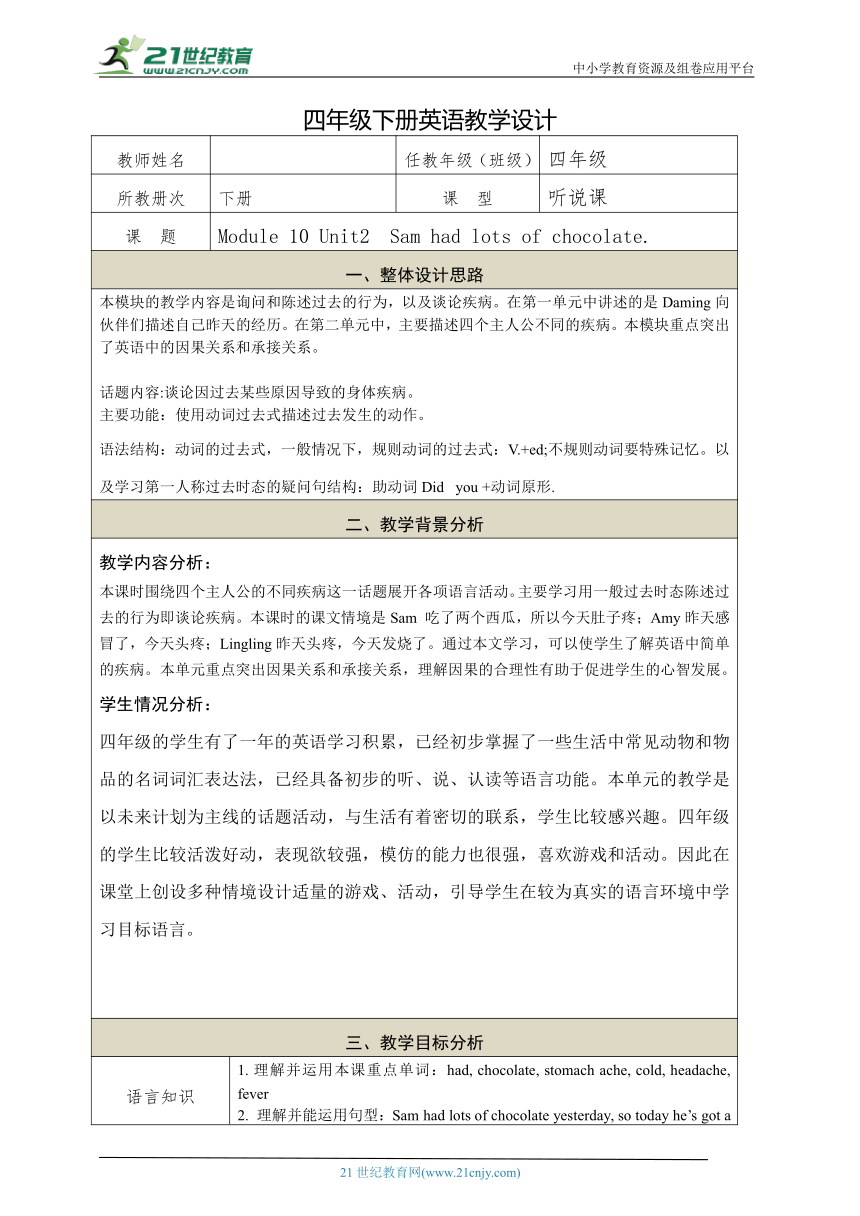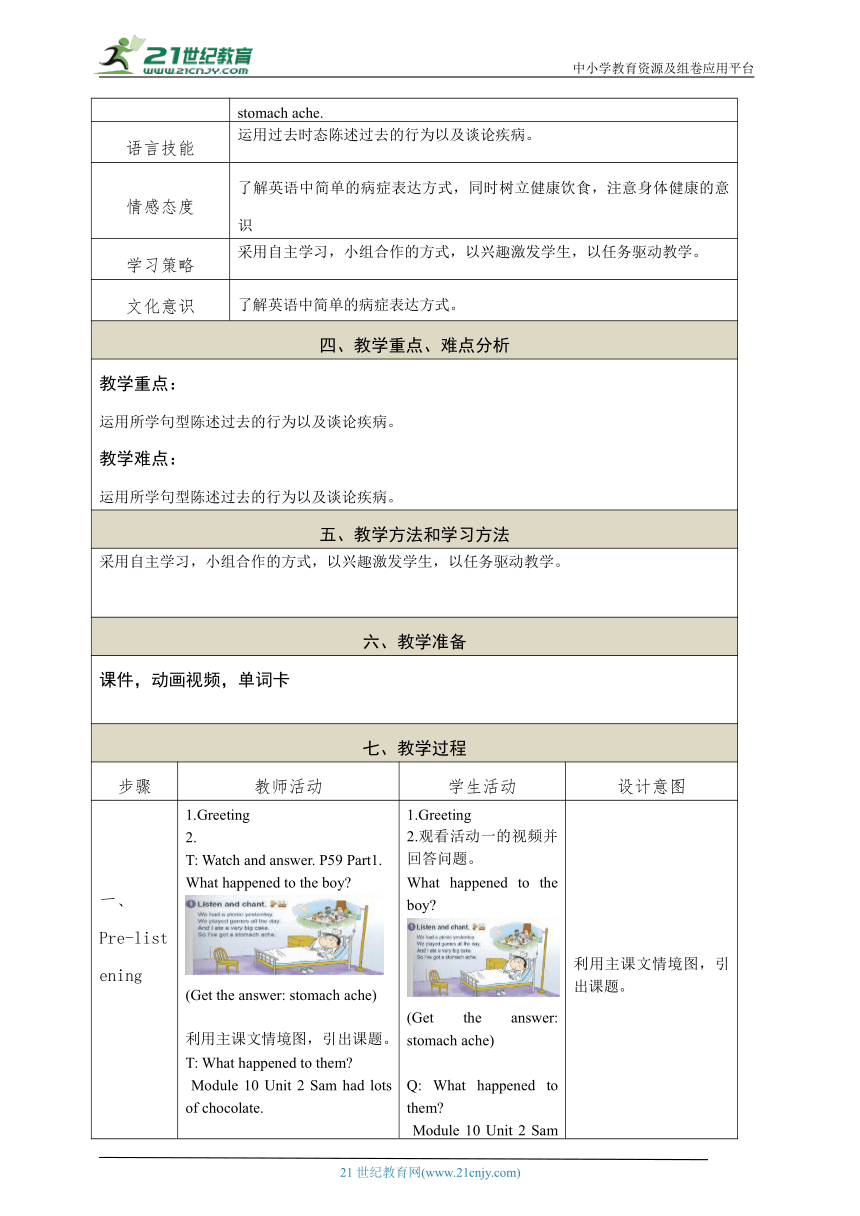Module 10 Unit2 Sam had lots of chocolate.教学设计
文档属性
| 名称 | Module 10 Unit2 Sam had lots of chocolate.教学设计 |  | |
| 格式 | docx | ||
| 文件大小 | 376.8KB | ||
| 资源类型 | 试卷 | ||
| 版本资源 | 外研版(三年级起点) | ||
| 科目 | 英语 | ||
| 更新时间 | 2024-03-18 09:58:18 | ||
图片预览



文档简介
中小学教育资源及组卷应用平台
四年级下册英语教学设计
教师姓名 任教年级(班级) 四年级
所教册次 下册 课 型 听说课
课 题 Module 10 Unit2 Sam had lots of chocolate.
一、整体设计思路
本模块的教学内容是询问和陈述过去的行为,以及谈论疾病。在第一单元中讲述的是Daming向伙伴们描述自己昨天的经历。在第二单元中,主要描述四个主人公不同的疾病。本模块重点突出了英语中的因果关系和承接关系。 话题内容:谈论因过去某些原因导致的身体疾病。 主要功能:使用动词过去式描述过去发生的动作。 语法结构:动词的过去式,一般情况下,规则动词的过去式:V.+ed;不规则动词要特殊记忆。以及学习第一人称过去时态的疑问句结构:助动词Did you +动词原形.
二、教学背景分析
教学内容分析: 本课时围绕四个主人公的不同疾病这一话题展开各项语言活动。主要学习用一般过去时态陈述过去的行为即谈论疾病。本课时的课文情境是Sam 吃了两个西瓜,所以今天肚子疼;Amy昨天感冒了,今天头疼;Lingling昨天头疼,今天发烧了。通过本文学习,可以使学生了解英语中简单的疾病。本单元重点突出因果关系和承接关系,理解因果的合理性有助于促进学生的心智发展。 学生情况分析: 四年级的学生有了一年的英语学习积累,已经初步掌握了一些生活中常见动物和物品的名词词汇表达法,已经具备初步的听、说、认读等语言功能。本单元的教学是以未来计划为主线的话题活动,与生活有着密切的联系,学生比较感兴趣。四年级的学生比较活泼好动,表现欲较强,模仿的能力也很强,喜欢游戏和活动。因此在课堂上创设多种情境设计适量的游戏、活动,引导学生在较为真实的语言环境中学习目标语言。
三、教学目标分析
语言知识 1. 理解并运用本课重点单词:had, chocolate, stomach ache, cold, headache, fever 2. 理解并能运用句型:Sam had lots of chocolate yesterday, so today he’s got a stomach ache.
语言技能 运用过去时态陈述过去的行为以及谈论疾病。
情感态度 了解英语中简单的病症表达方式,同时树立健康饮食,注意身体健康的意识
学习策略 采用自主学习,小组合作的方式,以兴趣激发学生,以任务驱动教学。
文化意识 了解英语中简单的病症表达方式。
四、教学重点、难点分析
教学重点: 运用所学句型陈述过去的行为以及谈论疾病。 教学难点: 运用所学句型陈述过去的行为以及谈论疾病。
五、教学方法和学习方法
采用自主学习,小组合作的方式,以兴趣激发学生,以任务驱动教学。
六、教学准备
课件,动画视频,单词卡
七、教学过程
步骤 教师活动 学生活动 设计意图
一、Pre-listening 1.Greeting 2. T: Watch and answer. P59 Part1. What happened to the boy (Get the answer: stomach ache) 利用主课文情境图,引出课题。 T: What happened to them Module 10 Unit 2 Sam had lots of chocolate. 通过Chant热身导入,引出新短语:have got及新单词: stomach ache。 1.Greeting 2.观看活动一的视频并回答问题。 What happened to the boy (Get the answer: stomach ache) Q: What happened to them Module 10 Unit 2 Sam had lots of chocolate. 通过Chant热身导入,引出新短语:have got及新单词: stomach ache。 利用主课文情境图,引出课题。
三、While-listening 1.主课文第一幅情境图。 1) 看图说一说。 have chocolate get a stomach ache Try to say: Sam had lots of chocolate yesterday, so today he’s got a stomach ache. (he’s got = he has got) 2) 听录音,再说一说。 3) 观看视频并跟读。 2.主课文第二幅情境图。 1) 看图说一说。 have watermelons get a stomach ache Try to say: Daming had two watermelons yesterday, so today he’s got a stomach ache. (he’s got = he has got) 2) 听录音,再说一说。 3) 观看视频并跟读。 3.主课文第三幅情境图。 1) 看图说一说。 have a cold get a headache (Learn the new words: cold; headache) Try to say: Amy had a cold yesterday, and today she’s got a headache. (she’s got= she has got) 2) 听录音,再说一说。 3) 观看视频并跟读。 4. 主课文第四幅情境图。 1) 看图说一说。 have a headache get a fever (Learn the new word: fever) Try to say: Lingling had a headache yesterday, and today she’s got a fever. (she’s got = she has got) 2) 听录音,再说一说。 3) 观看视频并跟读。 通过Sam 吃巧克力的图片引导学生自己说出have chocolate, 再通过观察图片引出get a stomach ache;最后加入时态yesterday,先引导学生自己说句子,然后再提供听力材料,引导孩子们自己发现问题,自己解决问题;最后观看动画并模仿语音语调,再次加强对文本的学习。 通过对Sam生病图片的学习,引领同学们自己思考并能进一步回答Daming生病的图片。 通过对前两幅图的学习,已经掌握了基本的句型结构,因此引领学生自己根据图片描述句子。 1.主课文第一幅情境图。 1) 看图说一说。 have chocolate get a stomach ache Try to say: Sam had lots of chocolate yesterday, so today he’s got a stomach ache. (he’s got = he has got) 2) 听录音,再说一说。 3) 观看视频并跟读。 2.主课文第二幅情境图。 1) 看图说一说。 have watermelons get a stomach ache Try to say: Daming had two watermelons yesterday, so today he’s got a stomach ache. (he’s got = he has got) 2) 听录音,再说一说。 3) 观看视频并跟读。 3.主课文第三幅情境图。 1) 看图说一说。 have a cold get a headache (Learn the new words: cold; headache) Try to say: Amy had a cold yesterday, and today she’s got a headache. (she’s got= she has got) 2) 听录音,再说一说。 3) 观看视频并跟读。 4. 主课文第四幅情境图。 1) 看图说一说。 have a headache get a fever (Learn the new word: fever) Try to say: Lingling had a headache yesterday, and today she’s got a fever. (she’s got = she has got) 2) 听录音,再说一说。 3) 观看视频并跟读。 通过Sam 吃巧克力的图片引导学生自己说出have chocolate, 再通过观察图片引出get a stomach ache;最后加入时态yesterday,先引导学生自己说句子,然后再提供听力材料,引导孩子们自己发现问题,自己解决问题;最后观看动画并模仿语音语调,再次加强对文本的学习。 通过对Sam生病图片的学习,引领同学们自己思考并能进一步回答Daming生病的图片。 通过对前两幅图的学习,已经掌握了基本的句型结构,因此引领学生自己根据图片描述句子。
三、Post-listening 1.分角色朗读课文,并表演。 Read and role play. 2.看图说话。Point and say. P60 Part3. 1.分角色朗读课文,并表演。 Read and role play. 2.看图说话。Point and say. P60 Part3. 学生把本课所学文本进行分角色表演,并看图说话,将所学目标语言进行有效的输出。
八、板书设计
Module10 Unit2 Sam had lots of chocolate.
九、作业设计
1. Listen, read and imitate the text. 2. Share a story about yourself to your friends.
十、教学反思
21世纪教育网 www.21cnjy.com 精品试卷·第 2 页 (共 2 页)
21世纪教育网(www.21cnjy.com)
四年级下册英语教学设计
教师姓名 任教年级(班级) 四年级
所教册次 下册 课 型 听说课
课 题 Module 10 Unit2 Sam had lots of chocolate.
一、整体设计思路
本模块的教学内容是询问和陈述过去的行为,以及谈论疾病。在第一单元中讲述的是Daming向伙伴们描述自己昨天的经历。在第二单元中,主要描述四个主人公不同的疾病。本模块重点突出了英语中的因果关系和承接关系。 话题内容:谈论因过去某些原因导致的身体疾病。 主要功能:使用动词过去式描述过去发生的动作。 语法结构:动词的过去式,一般情况下,规则动词的过去式:V.+ed;不规则动词要特殊记忆。以及学习第一人称过去时态的疑问句结构:助动词Did you +动词原形.
二、教学背景分析
教学内容分析: 本课时围绕四个主人公的不同疾病这一话题展开各项语言活动。主要学习用一般过去时态陈述过去的行为即谈论疾病。本课时的课文情境是Sam 吃了两个西瓜,所以今天肚子疼;Amy昨天感冒了,今天头疼;Lingling昨天头疼,今天发烧了。通过本文学习,可以使学生了解英语中简单的疾病。本单元重点突出因果关系和承接关系,理解因果的合理性有助于促进学生的心智发展。 学生情况分析: 四年级的学生有了一年的英语学习积累,已经初步掌握了一些生活中常见动物和物品的名词词汇表达法,已经具备初步的听、说、认读等语言功能。本单元的教学是以未来计划为主线的话题活动,与生活有着密切的联系,学生比较感兴趣。四年级的学生比较活泼好动,表现欲较强,模仿的能力也很强,喜欢游戏和活动。因此在课堂上创设多种情境设计适量的游戏、活动,引导学生在较为真实的语言环境中学习目标语言。
三、教学目标分析
语言知识 1. 理解并运用本课重点单词:had, chocolate, stomach ache, cold, headache, fever 2. 理解并能运用句型:Sam had lots of chocolate yesterday, so today he’s got a stomach ache.
语言技能 运用过去时态陈述过去的行为以及谈论疾病。
情感态度 了解英语中简单的病症表达方式,同时树立健康饮食,注意身体健康的意识
学习策略 采用自主学习,小组合作的方式,以兴趣激发学生,以任务驱动教学。
文化意识 了解英语中简单的病症表达方式。
四、教学重点、难点分析
教学重点: 运用所学句型陈述过去的行为以及谈论疾病。 教学难点: 运用所学句型陈述过去的行为以及谈论疾病。
五、教学方法和学习方法
采用自主学习,小组合作的方式,以兴趣激发学生,以任务驱动教学。
六、教学准备
课件,动画视频,单词卡
七、教学过程
步骤 教师活动 学生活动 设计意图
一、Pre-listening 1.Greeting 2. T: Watch and answer. P59 Part1. What happened to the boy (Get the answer: stomach ache) 利用主课文情境图,引出课题。 T: What happened to them Module 10 Unit 2 Sam had lots of chocolate. 通过Chant热身导入,引出新短语:have got及新单词: stomach ache。 1.Greeting 2.观看活动一的视频并回答问题。 What happened to the boy (Get the answer: stomach ache) Q: What happened to them Module 10 Unit 2 Sam had lots of chocolate. 通过Chant热身导入,引出新短语:have got及新单词: stomach ache。 利用主课文情境图,引出课题。
三、While-listening 1.主课文第一幅情境图。 1) 看图说一说。 have chocolate get a stomach ache Try to say: Sam had lots of chocolate yesterday, so today he’s got a stomach ache. (he’s got = he has got) 2) 听录音,再说一说。 3) 观看视频并跟读。 2.主课文第二幅情境图。 1) 看图说一说。 have watermelons get a stomach ache Try to say: Daming had two watermelons yesterday, so today he’s got a stomach ache. (he’s got = he has got) 2) 听录音,再说一说。 3) 观看视频并跟读。 3.主课文第三幅情境图。 1) 看图说一说。 have a cold get a headache (Learn the new words: cold; headache) Try to say: Amy had a cold yesterday, and today she’s got a headache. (she’s got= she has got) 2) 听录音,再说一说。 3) 观看视频并跟读。 4. 主课文第四幅情境图。 1) 看图说一说。 have a headache get a fever (Learn the new word: fever) Try to say: Lingling had a headache yesterday, and today she’s got a fever. (she’s got = she has got) 2) 听录音,再说一说。 3) 观看视频并跟读。 通过Sam 吃巧克力的图片引导学生自己说出have chocolate, 再通过观察图片引出get a stomach ache;最后加入时态yesterday,先引导学生自己说句子,然后再提供听力材料,引导孩子们自己发现问题,自己解决问题;最后观看动画并模仿语音语调,再次加强对文本的学习。 通过对Sam生病图片的学习,引领同学们自己思考并能进一步回答Daming生病的图片。 通过对前两幅图的学习,已经掌握了基本的句型结构,因此引领学生自己根据图片描述句子。 1.主课文第一幅情境图。 1) 看图说一说。 have chocolate get a stomach ache Try to say: Sam had lots of chocolate yesterday, so today he’s got a stomach ache. (he’s got = he has got) 2) 听录音,再说一说。 3) 观看视频并跟读。 2.主课文第二幅情境图。 1) 看图说一说。 have watermelons get a stomach ache Try to say: Daming had two watermelons yesterday, so today he’s got a stomach ache. (he’s got = he has got) 2) 听录音,再说一说。 3) 观看视频并跟读。 3.主课文第三幅情境图。 1) 看图说一说。 have a cold get a headache (Learn the new words: cold; headache) Try to say: Amy had a cold yesterday, and today she’s got a headache. (she’s got= she has got) 2) 听录音,再说一说。 3) 观看视频并跟读。 4. 主课文第四幅情境图。 1) 看图说一说。 have a headache get a fever (Learn the new word: fever) Try to say: Lingling had a headache yesterday, and today she’s got a fever. (she’s got = she has got) 2) 听录音,再说一说。 3) 观看视频并跟读。 通过Sam 吃巧克力的图片引导学生自己说出have chocolate, 再通过观察图片引出get a stomach ache;最后加入时态yesterday,先引导学生自己说句子,然后再提供听力材料,引导孩子们自己发现问题,自己解决问题;最后观看动画并模仿语音语调,再次加强对文本的学习。 通过对Sam生病图片的学习,引领同学们自己思考并能进一步回答Daming生病的图片。 通过对前两幅图的学习,已经掌握了基本的句型结构,因此引领学生自己根据图片描述句子。
三、Post-listening 1.分角色朗读课文,并表演。 Read and role play. 2.看图说话。Point and say. P60 Part3. 1.分角色朗读课文,并表演。 Read and role play. 2.看图说话。Point and say. P60 Part3. 学生把本课所学文本进行分角色表演,并看图说话,将所学目标语言进行有效的输出。
八、板书设计
Module10 Unit2 Sam had lots of chocolate.
九、作业设计
1. Listen, read and imitate the text. 2. Share a story about yourself to your friends.
十、教学反思
21世纪教育网 www.21cnjy.com 精品试卷·第 2 页 (共 2 页)
21世纪教育网(www.21cnjy.com)
同课章节目录
- Module 1
- Unit 1 She's a nice teache
- Unit 2 He's cool.
- Module 2
- Unit 1 London is a big city.
- Unit 2 It's very old.
- Module 3
- Unit 1 Robots will do everything.
- Unit 2 On Monday I'll go swimming.
- Module 4
- Unit 1 Will you take your kite?
- Unit 2 Will it be hot in Haikou?
- Module 5
- Unit 1 I was two then.
- Unit 2 They were young.
- Module 6
- Unit 1 Were you at home yesterday?
- Unit 2 Was it a big city then ?
- Module 7
- Unit 1 I helped Mum.
- Unit 2 Grandma cooked fish.
- Module 8
- Unit 1 They sang beautifully.
- Unit 2 I took some pictures.
- Module 9
- Unit 1 Did he live in New York ?
- Unit 2 Did you have a nice holiday?
- Review Module
- Unit 1
- Unit 2
- Module 10
- Unit 1 Did you fall off your bike?
- Unit 2 Sam had lots of chocolate.
